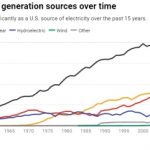Financial support for the transition needs clear and carefully chosen definitions of what qualifies for that support. Getting it wrong leads to unintended consequences, some which may not reduce emissions, explains James Sallee at the Energy Institute at Haas. Ever wondered why SUVs and big cars proliferated after the 1970s in the U.S. (and are on roads all over the world now)? The 1970s oil crisis triggered new rules that penalised fuel … [Read more...]
Industrial Policy: China’s always had it, the U.S. has rediscovered it, the EU now needs it too
China’s performance – both in and outside the energy sector – has always been driven by wide-reaching industrial policy. In the last few decades it has consistently delivered results. Meanwhile, the U.S. has kept shifting up the gears of its pro-U.S. interventionist industrial policy since Donald Trump: though socially right wing, he was a protectionist president whose ambition was to boost domestic industries. Today, president Biden’s “Inflation … [Read more...]
IPCC Report on Adaptation: a rapidly closing policy window for climate change action
We do not know how successful we will be at cutting emissions. So “adaptation” is how we change our behaviour, economies, infrastructure and planning to cope with the consequences of climate change. The IPCC’s 6th and latest report looks at the scientific evidence of climate risk and the adaptation solutions being pursued around the world. Alexandre Magnan at IDDRI summarises the findings. It says that by 2100 climate risk will increase two- to … [Read more...]
What’s your average lifetime CO2 footprint by year of birth, to achieve net-zero by 2050?
To reach net zero by 2050, babies born today must have CO2 footprints ten times smaller over their lifetimes than their parents and grandparents. In rich countries it’ll be fifteen times, while in emerging economies like India and China it’ll be around four times smaller. Laura Cozzi, Olivia Chen and Hyeji Kim at the IEA summarise how they have calculated the average allowable lifetime CO2 footprint by year of birth. Taking the two extremes, the … [Read more...]
District Heating Roundtable: Policy across RED, EED and EPBD “must take account of conditions in all Member States”
Sara Stefanini provides a written summary of our panel discussion held on 10th February: District Heating under the "Fit for 55" package: challenges and opportunities. Under the “Fit for 55” package, the EC proposed several regulatory changes that, combined, are meant to decarbonise district heating in Europe. But are these options workable for all? The participants raise questions over the support for district heating, whether the multiple … [Read more...]
District Heating: policies for cutting emissions need work says IEA
District Heating policies need urgent attention according to the IEA so here in Europe it's a good moment to examine what the "Fit for 55" package means for the sector's future development. On February 10 Energy Post is hosting an online roundtable alongside MEP Pernille Weiss, MEP Morten Petersen, and MEP Grzegorz Tobiszowski - all (senior) members of the ITRE committee - to take in the viewpoints of key Member States and stakeholders (COGEN … [Read more...]
HBr Flow Batteries: long term storage for grids, compatible with hydrogen
The growth of intermittent wind and solar and the search for replacements for coal and gas points at storage solutions that can ensure a reliable supply of electricity at all times. Standard lithium-ion batteries have limitations. Put simply, the future demand for batteries (including for transport) is expected to far outstrip the supply of lithium. But hydrogen and bromine are abundantly available on a global scale. Helena Uhde and Veronika … [Read more...]
How to incentivise “differentiated” low-methane-emissions Gas
Cutting methane emissions from gas production is a major part of the world’s strategy to limit temperature rises. The IEA says we need a 77% drop in methane emissions by 2030. The question is how to target and enact globally the required incentives and regulations that favour “differentiated” low-methane-emissions gas. Regulating international trade sounds like a great starting point, as an importer like the EU can twist the arm of anyone who … [Read more...]
Energy professionals: do you understand how the media works?
We energy professionals spend most of our time talking to each other. But, more than ever, climate change and the energy transition are headline news. That’s not just in the mainstream media but also within our industry journals and the policy-maker press. So, we need to understand how the media works. More specifically for many, we need to know how to handle our PR providers. Sean Crowley says it’s up to us to work more effectively with the … [Read more...]
CEPP incentives and penalties: current design could undermine U.S. clean energy growth
The Clean Electricity Performance Program (CEPP) is a key part of President Biden’s energy and climate plans. It will steer utilities towards clean energy with incentives and penalties, and is still being designed. Severin Borenstein and James Bushnell at the Energy Institute at Haas, Steve Cicala at Tufts University and Ryan Kellogg at the University of Chicago warn that current proposals will allow utilities to game the system, resulting in … [Read more...]
Europe’s Carbon Capture pipeline: 40+ projects. But where’s the policy support and market creation?
13 different European countries have announced more than 40 carbon capture projects. Most are yet to become operational, but the commitment from the private sector – ranging from new players to established energy and industry majors – is clear. Now is the time for governments to create for CCUS the kind of policies that accelerated the growth of wind and solar, says Lee Beck at the Clean Air Task Force. Norway and the Netherlands are taking those … [Read more...]
European Commission should intensify political action in 2021 to align Renovation Wave with EU Climate Targets, BPIE says.
In its new analysis, BPIE (Buildings Performance Institute Europe) urges the European Commission to intensify political coordination and coherence in the implementation phase of the Renovation Wave strategy, to ensure full decarbonisation of the EU building stock in line with EU climate goals. … [Read more...]
The EU needs an independent science-led climate watchdog, a European Climate Change Council
Europe does not have the right institutional set-up for robust independent policy evaluation as the region enters a new, complex and radical stage of its energy and climate transition, argue Lola Vallejo (IDDRI), Alina Averchenkova (GRI), Matthias Duwe (Ecologic Institute) and Lara Lázaro Touza (Real Instituto Elcano). This month 12 expert advisory bodies in 11 EU Member States published a letter to EU policy-makers to launch an EU-level body, a … [Read more...]
Long-Term Renovation Strategies not on track to deliver climate-neutrality by 2050, indicating need for full revision of Energy Performance of Buildings Directive
A new report by the Buildings Performance Institute Europe (BPIE) finds that EU Member States continue to underplay the role of the building sector in delivering a climate-neutral Europe. … [Read more...]
Are Regulations and Climate Activism the main driver for coal exits, not Gas and Renewables prices?
It’s widely thought in the media and politics that market forces are now the primary driver for the demise of coal: mainly natural gas prices, and the rising adoption and competitiveness of wind and solar. However, David Drake and Jeffrey York at the University of Colorado Boulder present their research from the U.S. that suggests the two main drivers are federal policy and climate activism. They studied the retirement of 348 coal-fired units … [Read more...]















